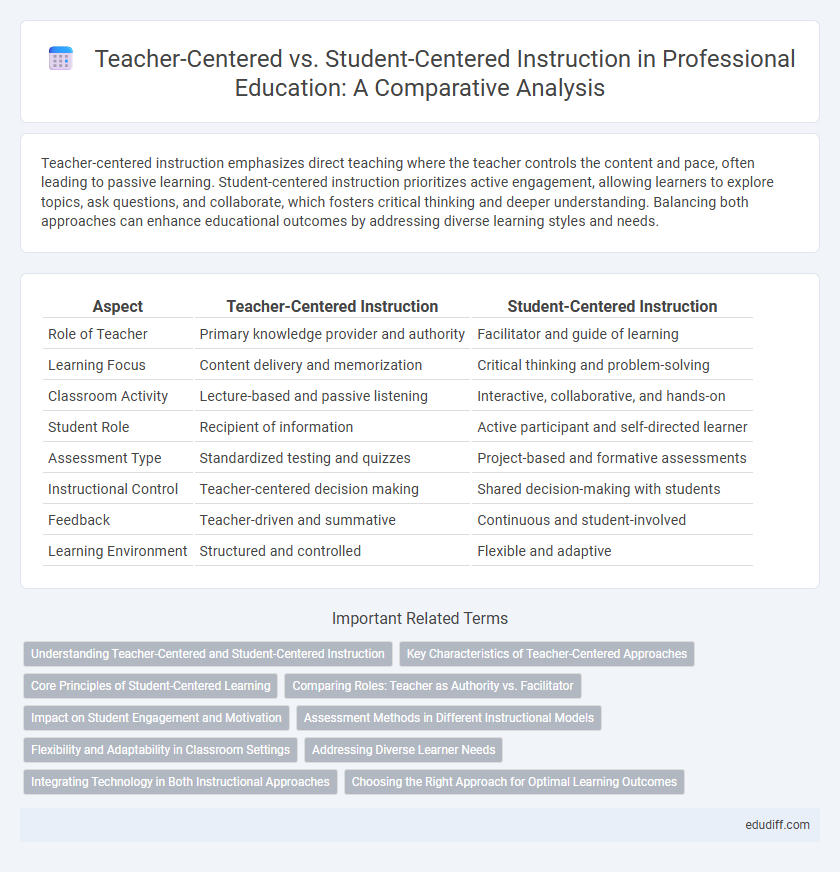Teacher-centered instruction emphasizes direct teaching where the teacher controls the content and pace, often leading to passive learning. Student-centered instruction prioritizes active engagement, allowing learners to explore topics, ask questions, and collaborate, which fosters critical thinking and deeper understanding. Balancing both approaches can enhance educational outcomes by addressing diverse learning styles and needs.
Table of Comparison
| Aspect | Teacher-Centered Instruction | Student-Centered Instruction |
|---|---|---|
| Role of Teacher | Primary knowledge provider and authority | Facilitator and guide of learning |
| Learning Focus | Content delivery and memorization | Critical thinking and problem-solving |
| Classroom Activity | Lecture-based and passive listening | Interactive, collaborative, and hands-on |
| Student Role | Recipient of information | Active participant and self-directed learner |
| Assessment Type | Standardized testing and quizzes | Project-based and formative assessments |
| Instructional Control | Teacher-centered decision making | Shared decision-making with students |
| Feedback | Teacher-driven and summative | Continuous and student-involved |
| Learning Environment | Structured and controlled | Flexible and adaptive |
Understanding Teacher-Centered and Student-Centered Instruction
Teacher-centered instruction emphasizes the teacher as the primary source of knowledge, often utilizing lectures, direct instruction, and structured activities to deliver content efficiently. Student-centered instruction prioritizes active learning, encouraging students to engage in problem-solving, collaboration, and critical thinking, fostering deeper understanding and autonomy. Understanding these approaches involves recognizing their impact on student motivation, classroom dynamics, and learning outcomes.
Key Characteristics of Teacher-Centered Approaches
Teacher-centered instruction emphasizes structured, lecture-based delivery where the teacher controls the learning environment and content. It prioritizes mastery of foundational knowledge through direct instruction, rote memorization, and standardized assessments. This approach often features a hierarchical classroom dynamic with clear expectations and limited student autonomy.
Core Principles of Student-Centered Learning
Student-centered learning prioritizes active engagement, collaboration, and critical thinking by placing students at the heart of the educational process. Core principles include personalized learning experiences, fostering autonomy, and promoting problem-solving skills that adapt to individual needs and interests. This approach contrasts with teacher-centered instruction by emphasizing student responsibility and interactive participation over passive absorption of information.
Comparing Roles: Teacher as Authority vs. Facilitator
In teacher-centered instruction, the teacher assumes the role of an authoritative figure who directs learning, delivers content, and controls classroom activities, ensuring strict adherence to curriculum standards. Conversely, student-centered instruction positions the teacher as a facilitator who guides, supports, and encourages students to take an active role in their own learning through collaboration, inquiry, and critical thinking. This shift in roles emphasizes autonomy, personalized learning, and the development of higher-order cognitive skills, fostering a more engaging and participatory educational environment.
Impact on Student Engagement and Motivation
Teacher-centered instruction often results in passive student participation, limiting opportunities for active engagement and reducing intrinsic motivation. In contrast, student-centered instruction promotes collaboration, critical thinking, and autonomy, which significantly enhances student engagement and fosters sustained motivation. Research indicates that classrooms emphasizing student-centered learning environments see higher levels of academic achievement and greater enthusiasm for learning among students.
Assessment Methods in Different Instructional Models
Teacher-centered instruction commonly employs summative assessments such as standardized tests and quizzes to evaluate student learning, emphasizing content mastery and retention. In contrast, student-centered instruction integrates formative assessments like peer reviews, project-based evaluations, and self-assessments, fostering critical thinking and personalized feedback. These differing assessment methods reflect the instructional models' focus on either teacher-led evaluation or active student participation in the learning process.
Flexibility and Adaptability in Classroom Settings
Teacher-centered instruction provides a structured environment where the educator directs learning, but often limits flexibility in addressing diverse student needs. In contrast, student-centered instruction emphasizes adaptability, allowing teachers to modify lessons based on student feedback, interests, and learning styles. The ability to pivot teaching methods enhances engagement and supports individualized learning outcomes in dynamic classroom settings.
Addressing Diverse Learner Needs
Teacher-centered instruction often relies on structured, standardized methods that may not fully accommodate diverse learner needs, limiting opportunities for personalized engagement. Student-centered instruction prioritizes differentiated strategies, adapting to individual learning styles, cultural backgrounds, and abilities to enhance inclusivity and comprehension. Implementing adaptive technologies and formative assessments within student-centered frameworks effectively supports diverse learners by providing tailored feedback and fostering active participation.
Integrating Technology in Both Instructional Approaches
Teacher-centered instruction often utilizes technology to deliver structured content through interactive whiteboards and presentation software, enhancing direct teaching efficiency. Student-centered instruction integrates technology by promoting collaborative tools, such as online discussion platforms and digital project-based learning environments, fostering active student engagement and personalized learning. Combining these approaches with adaptive learning technologies can optimize educational outcomes by balancing guided instruction and student autonomy.
Choosing the Right Approach for Optimal Learning Outcomes
Teacher-centered instruction emphasizes direct instruction and structured environments, ideal for foundational knowledge acquisition and standardized assessments. Student-centered approaches promote active learning, critical thinking, and collaboration, enhancing engagement and long-term retention. Selecting the right approach depends on curriculum goals, learner needs, and desired cognitive skills to optimize educational outcomes.
Teacher-Centered vs Student-Centered Instruction Infographic

 edudiff.com
edudiff.com